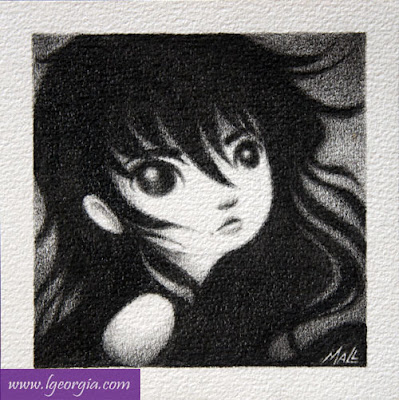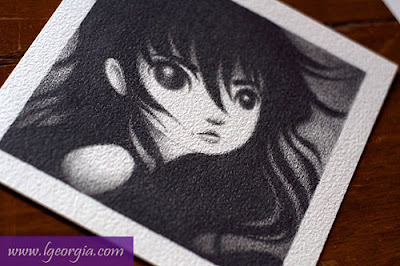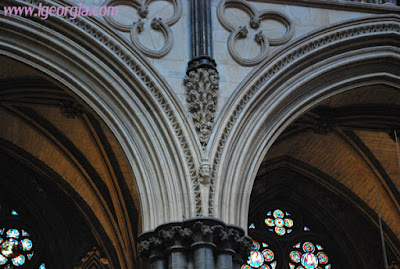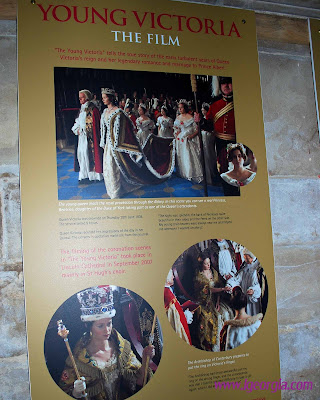We Filipinos are very superstitious lot. I personally did not really believe, did not plan to follow any until my brother passionately cautioned me against fitting my wedding dress (before the wedding). A retort of “
” was in the tip of the tongue but after a few seconds of intensive parsing the words that rolled out were “
” Oh before you accuse me of being a sissy, I am agreeing to his well meant advice because it is not wise to tempt fate. It’s better to be on the safe side than sorry, right?
Well I did some researching of what other wedding superstitions are out there (just so I can make a list of what to avoid hehe). Gosh there are so many! I am so relieved that I have not yet violated any. I was surprised to know that here in UK they have more wedding customs and superstitions than we have. In fact I suspect most of our superstitions originated here. Read on.
In the past when the marriage proposal was a more formal procedure, the prospective groom sent his friends or members of his family to represent his interests to the prospective bride and her family. If they saw a blind man, a monk or a pregnant woman during their journey it was thought that the marriage would be doomed if they continued their journey as these sights were thought to be bad omens.
If, however, they saw nanny goats, pigeons or wolves these were good omens which would bring good fortune to the marriage.
It was thought unlucky for a woman to marry a man whose surname began with the same letter as hers. The sentiment was summarised in the following rhyme:
To change the name and not the letter
Is to change for the worst and not the better
The bride should not practice writing her new name before the wedding. This is thought to bring bad luck by tempting fate.
Although most weddings now take place on a Saturday it was considered unlucky in the past. Fridays were also considered unlucky particularly Friday the 13th. The famous old rhyme advises a wedding in the first half of the week:
Monday for wealth
Tuesday for health
Wednesday the best day of all
Thursday for losses
Friday for crosses
Saturday for no luck at all
Advice on which month to marry in is given by the following rhyme:
Married when the year is new, he'll be loving, kind and true.
When February birds do mate, You wed nor dread your fate.
If you wed when March winds blow, joy and sorrow both you'll know.
Marry in April when you can, Joy for Maiden and for Man.
Marry in the month of May, and you'll surely rue the day.
Marry when June roses grow, over land and sea you'll go.
Those who in July do wed, must labour for their daily bred.
Whoever wed in August be, many a change is sure to see
Marry in September's shrine, your living will be rich and fine.
If in October you do marry, love will come but riches tarry.
If you wed in bleak November, only joys will come, remember.
When December snows fall fast, marry and true love will last.
Marry in May and you'll live to rue the day
May has been considered an unlucky month to marry in for a number of reasons. In Pagan times the start of summer was when the festival of Beltane was celebrated with outdoor orgies (what?). This was therefore thought to be an unsuitable time to start married life. In Roman times the Feast of the Dead and the festival of the goddess of chastity both occurred in May. The advice was taken more seriously in Victorian times than it is today. In most Churches the end of April was a busy time for weddings as couples wanted to avoid being married in May. Queen Victoria is thought to have forbidden her children from marrying in May.
Marry in Lent, live to repent
Lent was thought an inappropriate time for a wedding as this was a time of abstinence.
June was considered to be a lucky month to marry in because it is named after Juno, the Roman goddess of love and marriage.
The Summer as a whole was considered a good time to marry and this is partly to do with the sun's association with fertility. In Scotland one popular custom was for the bride to "walk with the sun" to bring her good. She would walk from east to west on the south side of the church and then continue walking around the church three times.
- SOMETHING OLD, SOMETHING NEW ...
Something old, something new
Something borrowed, something blue
And a silver sixpence in your shoe
The rhyme originated in Victorian times although some of customs referred in it are much older.
The something old represents the couples friends who will hopefully remain close during the marriage. Traditionally this was old garter which given to the bride by a happily married woman in the hope that her happiness in marriage would be passed on to the new bride.
Something new symbolises the newlyweds' happy and prosperous future.
The something borrowed is often lent by the bride's family and is an item much valued by the family. The bride must return the item to ensure good luck.
The custom of the bride wearing something blue originated in ancient Israel where the bride wore a blue ribbon in her hair to represent fidelity.
The placing of a silver sixpence in the bride's shoe was to ensure wealth in the couples married life. Today some brides substitute a penny in their shoe during the ceremony as silver sixpences are less common.
It is thought unlucky for the bride to make her own wedding dress.
It is also unlucky for the groom to see the bride in her wedding dress before until she arrives at the ceremony.
The bride should not wear her entire outfit before the wedding day. Some brides leave a final stich on the dress undone until it is time to leave for the ceremony when the outfit is completed.
Most brides today marry in white which symbolises maidenhood. This tradition started by the rich in sixteenth century. The tradition was given a boost by Queen Victoria who chose to marry in white instead of silver which was the traditional colour of Royal brides. Before the white dress brides wore their best dress. The colour was a matter of preference. The following is a traditional rhyme offering advice on dress colour:
Married in White, you have chosen right,
Married in Blue, your love will always be true,
Married in Pearl, you will live in a whirl,
Married in Brown, you will live in town,
Married in Red, you will wish yourself dead,
Married in Yellow, ashamed of your fellow,
Married in Green, ashamed to be seen,
Married in Pink, your spirit will sink,
Married in Grey, you will go far away,
Married in Black, you will wish yourself back.
A green dress is thought to be unlucky unless the bride is Irish. The old expression that a woman has a 'green gown' was used to imply promiscuity, the green staining being due to rolling in grassy fields. (LOL.)
Traditionally, brides have been thought to be particularly vulnerable to evil spirits and many of the customs and traditions associated with weddings are to provide protection. The veil was originally worn by Roman brides. It was thought that it would disguise the bride and therefore outwit malevolent spirits.
Flowers have always been used for decoration at weddings.
Some people choose the flowers at the wedding on the basis of their symbolic meaning. For example orange blossom has always been associated with weddings because it signifies purity and chastity.
Peonies are avoided by some as they represent shame; azaleas represent temperance: roses symbolise love and snowdrops represent hope.
A combination of red and white flowers is avoided by the superstitious because they stand for blood and bandages.
However, people from different regions may attach other meanings to the same flower. For example lilies symbolise majesty to some but are thought unlucky by others because of their association with death.
The groom often chooses a flower for his buttonhole which also occurs in the bride's bouquet. This is a vestige of the time when a Knight would wear his Lady's colours to display his love.
- ON THE WAY TO THE WEDDING
When the bride is ready to leave the house for the wedding ceremony a last look in the mirror will bring her good luck. However returning to the mirror once she has began her journey will result in bad luck.
Seeing a chimney sweep on the way to a wedding is though to bring good luck and it is still possible to hire one to attend wedding ceremonies. Other good luck omens when seen on the way to the ceremony include lambs, toads, spiders, black cats and rainbows.
Seeing an open grave, a pig, a lizard, or hearing a cockerel crow after dawn are all thought to be omens of bad luck. Monks and nuns are also a bad omen. This may be because the are associated with poverty and chastity. They are also though to signal a dependence on charity by the newlyweds.
Bad weather on the way to the wedding is thought to be an omen of an unhappy marriage, although in some cultures rain is considered a good omen. Cloudy skies and wind are believed to cause stormy marriages. Snow on the other hand is associated with fertility and wealth.
Bridesmaids were dressed in a similar way to the bride for the same reason as the origin of veil. The bridesmaids were thought to act as decoys to confuse evil spirits and thus protect the bride.
Cutting the wedding cake is now part of the ritual celebrations at the reception. The couple make the first cut together to symbolise their shared future.
Confetti is Italian for sweets which in Italy are thrown over the couple as they emerge from the Church in that same way we use paper confetti. Raisins and nuts may also be used.
Before the use of paper confetti the married couple were showered with flowers, petals, rice or grains. This was to bestow prosperity and fertility on the couple.
In the past there have been a number of customs involving shoes which were thought to bring good luck. The best known, which is still upheld, is to tie shoes to the back of the newlyweds' car. This has evolved from the Tudor custom where guests would throw shoes at the newlywed couple. It was considered lucky if they or their carriage were hit.
The custom of the bride throwing her bouquet shoulder, described below, was originally performed by her throwing one of her shoes over her shoulder.
After the reception the bride throws her bouquet back over her shoulder where the unmarried female guest group together. Tradition holds that the one who catches the bouquet will be the next one of those present to marry.
A parallel custom is for the groom to remove the garter worn by the bride and throw it back over his shoulder toward the unmarried male guests. Again the one who catches it will be the next to marry.
After the wedding the bride must enter the new marital home through the main entrance. It is traditional for the groom to carry the bride over the threshold when they enter for the first time. The reason for this is uncertain. One explanation is that the bride will be visited by bad luck if she falls when entering. An alternative is that the bride will be unlucky if she steps into the new home with the left foot first. The bride can avoid both mishaps by being carried. A third explanation is that it symbolises the old Anglo-Saxon custom of the groom stealing his bride and carrying her off.
It is the best man's duty to protect the groom from bad luck. He must ensure that once the groom has began his journey to the church he does not return for any reason.
He must also arrange for the groom to carry a small mascot or charm in his pocket on the wedding day.
When the best man is paying the church minister's fee he should pay him an odd sum to bring luck to the couple.
The term "honeymoon" is though to originate from the times when a man captured his bride. The couple would hide from the bride's parents before marrying. The couple would remain in hiding for a further cycle of the moon after the wedding. During this period they drank honey wine.
In Scotland the custom was for a woman with milk in her breasts to prepare the marital bed to encourage fertility in the newlyweds.
In Ireland a laying hen was tied to the bed on the first honeymoon night in the hope that some of its fertility would be passed on to the couple. Eating a double yolked egg was also thought to bring fertility.





















.JPG)





.JPG)




 Punta Engaño Road Lapu-Lapu, Mactan Cebu PH
Punta Engaño Road Lapu-Lapu, Mactan Cebu PH U303 Zaravel Business Center, 27 Congressional Ave. Quezon City PH
U303 Zaravel Business Center, 27 Congressional Ave. Quezon City PH +63 917 322 4356 (for Cebu weddings)
+63 917 322 4356 (for Cebu weddings) La Union, Philippines
La Union, Philippines

 View Website
View Website